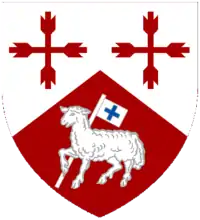Alfred Lawrence, 1st Baron Trevethin
Alfred Tristram Lawrence, 1st Baron Trevethin Kt PC DL (24 November 1843 – 3 August 1936) was a British lawyer and judge. He served as Lord Chief Justice of England and Wales from 1921 to 1922.
The Lord Trevethin | |
|---|---|
 | |
| Lord Chief Justice of England | |
| In office 15 April 1921 – 2 March 1922 | |
| Monarch | George V |
| Preceded by | The Earl of Reading |
| Succeeded by | The Lord Hewart |
| Personal details | |
| Born | 24 November 1843 Pontypool, Monmouthshire United Kingdom |
| Died | 3 August 1936 (aged 92) Builth, Brecknockshire United Kingdom |
| Alma mater | Trinity Hall, Cambridge |
| Occupation | Judge |
Lawrence was the eldest son of David Lawrence, a surgeon, of Pontypool, Monmouthshire, and Elizabeth, daughter of Charles Morgan Williams. He was educated at Trinity Hall, Cambridge, and was called to the Bar, Middle Temple, in 1869.[1] He established a successful legal practice although he did not become a Queen's Counsel until 1897. Lawrence was recorder for the Royal Borough of Windsor from 1885 to 1904, when he was appointed a Judge of the High Court of Justice (King's Bench Division).
In 1912, styled Mr Justice A.T. Lawrence, he established the legality of the football league's retain-and-transfer system with his judgement in the Kingaby case.[2] Former Aston Villa player Herbert Kingaby had brought legal proceedings against his old club for preventing him from playing. Erroneous strategy by Kingaby's counsel resulted in the suit being dismissed.[3]
In April 1921, aged 77, he was made Lord Chief Justice of England and Wales. He was admitted to the Privy Council at the same time and in August of the same year he was raised to the peerage as Baron Trevethin, of Blaengawney in the County of Monmouth. He was a stopgap as Lord Chief Justice. The Prime Minister David Lloyd George wanted Gordon Hewart to have the post but in the immediate term could not spare him from the House of Commons. On appointment, Lawrence gave Lloyd George a signed but undated letter of resignation.
He remained Lord Chief Justice until March 1922, when he resigned, to be succeeded by Hewart. He reputedly learned of his "resignation" when reading a newspaper on a train to London.
Lord Trevethin married his cousin Jessie Elizabeth, daughter of George Lawrence, in 1875. They had a daughter and four sons, of whom the eldest, Hon. Alfred Clive Lawrence, predeceased his father.
Lord Trevethin died in August 1936, aged 92. A keen angler in later life,[4] he suffered a seizure[1] while fishing in the River Wye above Builth Wells, fell in and drowned before he was taken out of the water.[1][4] He was cremated at Golders Green Crematorium.[4] He was succeeded in the barony by his second son Lieutenant-Colonel Charles Trevor Lawrence. His third son Hon. Geoffrey Lawrence also became a noted lawyer and was himself raised to the peerage as Baron Oaksey, before succeeding his elder brother in the barony of Trevethin in 1959.
Arms
  |
|
References
- "Lawrence, Alfred Tristram (LWRN864AT)". A Cambridge Alumni Database. University of Cambridge.
- Matthew Taylor, 'Sutcliffe, Charles Edward (1864–1939)’, Oxford Dictionary of National Biography, Oxford University Press, 2004
- David McArdle, LLB PhD, The Football League's player registration scheme and the Kingaby case Archived 24 November 2012 at the Wayback Machine, accessed 16 December 2012
- The Complete Peerage, Volume XIII - Peerage Creations 1901-1938. St Catherine's Press. 1949. p. 362.
- Debrett's Peerage. 1936.
Bibliography
- Wickham Legg, L. G. The Dictionary of National Biography, 1931–1940. Oxford University Press, 1949.
- Kidd, Charles, Williamson, David (editors). Debrett's Peerage and Baronetage (1990 edition). New York: St Martin's Press, 1990,
| Legal offices | ||
|---|---|---|
| Preceded by Earl of Reading |
Lord Chief Justice of England and Wales 1921–1922 |
Succeeded by Lord Hewart |
| Preceded by Reginald Brodie Dyke Acland |
Recorder of Oxford 1924 – ? |
Succeeded by Unknown |
| Peerage of the United Kingdom | ||
| Preceded by New Creation |
Baron Trevethin 1921–1936 |
Succeeded by Charles Lawrence |